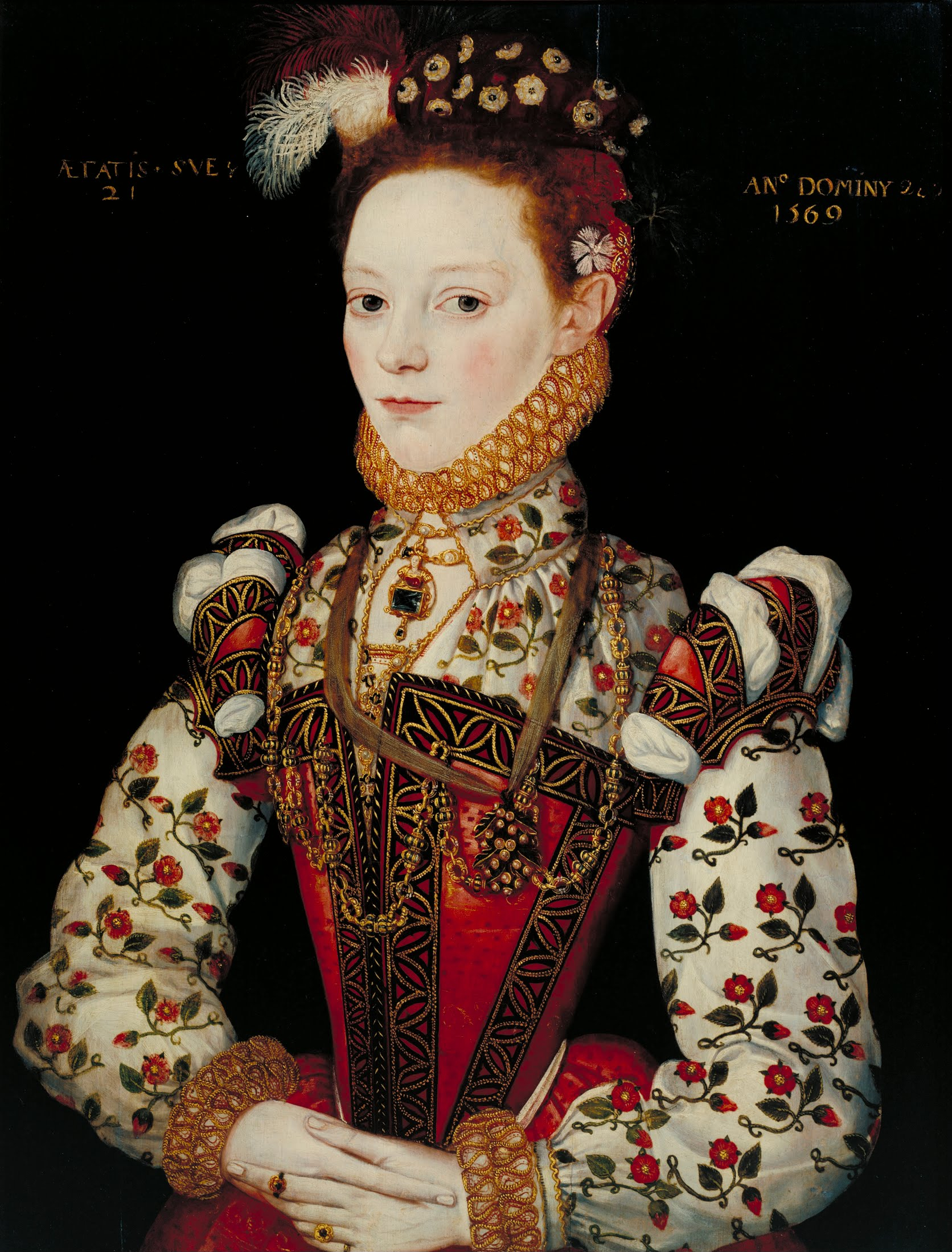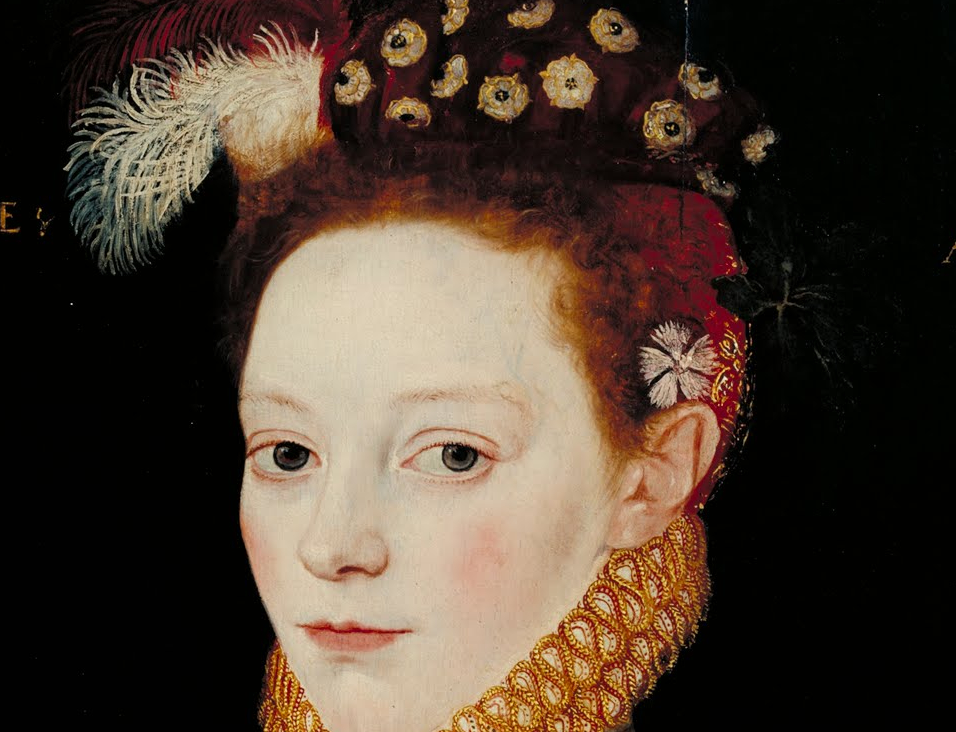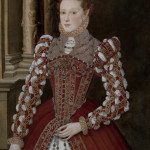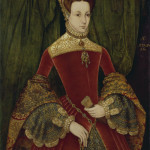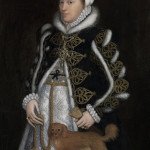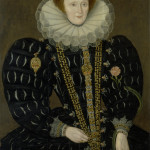A Young Lady Aged 21, Possibly Helena Snakenborg by Unknown artist of British School, 1569
This portrait on wooden panel, of a finely dressed young lady, is dated 1569 in an inscription, upper right. A second inscription, upper left, indicates that she is either aged 21 or in her 21styear. The history of this picture prior to the twentieth century is unknown.
Above her left ear, the sitter has a fresh carnation, often used in portraits as a symbol of betrothal. Behind it, in her soft brown hair, is a sprig of oak leaves – the oak symbolising constancy.
She wears two gold chains, a costly pendant in the form of a female figure holding a table-cut blue stone and, over her heart, another pendant or brooch in the form of five enamelled oak-leaves studded with pearls or clear stones, looped through a purple ribbon. Her sleeves are embroidered with red roses, and pinned to her cap are jewels in the shape of white roses. These are the two elements that make up the red-and-white Tudor rose, the symbol of the royal house of Elizabeth I (reigned 1558-1603) and thus here presumably an elegant sign of loyalty to the Queen.
In 1979, a Swedish literary historian, the late Dr Gunnar Sjogren, proposed that the sitter might be the Swedish-born Helena Snakenborg (1549-1635) who visited London in 1565 as a young maid of honour to the Swedish Princess Cecilia. There she attracted the attention of the elderly William Parr, Marquess of Northampton (1513-71), a brother of the deceased Henry VIII’s final queen, Catherine Parr (1512-48).
Elizabeth I encouraged Helena to remain in England. She was to become one of the Queen’s closest friends and was to serve her for 37 years, until Elizabeth’s death in 1603. Sjogren, noting that in 1569 Helena was in her 21st year, argued that the sitter’s central pendant (rather out of fashion by 1569) alluded to the Parr family crest of a maiden’s head, and could have been the Marquess’s personal gift to her, from the era of his youth, during his six-year engagement to Helena. She was married to Northampton in 1571, only six weeks before his death, and secondly, in 1576, to Thomas Gorges, a Groom of the Privy Chamber.
The identity of the artist is not known, but this painting shares some characteristics of handling with one of Anne Russell, Countess of Warwick (Woburn Abbey) and other portraits dating from around 1567-69 (see Roy Strong, The English Icon, London and New York 1969, pp.107-14). This unidentified painter is sometimes called ‘The Master of the Countess of Warwick’. Common elements include the soft treatment of the hair, the thinly outlined lips that meet in a straight horizontal line, and the minute attention given to the details of costume and jewellery.
Karen Hearn, May 2001
From Wikipedia:
Elin Ulfsdotter Snakenborg, Marchioness of Northampton, also known as Helena, and Helena the Red for her red hair, (1548/1549 – 10 April 1635) was a Swedish-born noblewoman, Maid of Honour of Queen Elizabeth I of England, and Marchioness of Northampton by her marriage to William Parr, 1st Marquess of Northampton.
She was born in Sweden, as Elin Ulfsdotter of Fyllingarum in the province of Ostrogothia, in either 1548 or 1549, as a younger daughter of Ulf Henriksson, lord of Fyllingarum (d. c. 1565), of the Bååt family. Senator of Sweden, and his wife Agneta Knutsdotter, heiress of Norrnes. Her father was a supporter of Gustav I, king of Sweden. By all accounts, Helena was a beautiful woman, with large brown eyes, red hair, and a pink and white complexion. She was described as having a strong will and independent mind.
Helena had two brothers and three sisters who survived childhood and had children of their own. Helena was baptized and given the name of her paternal grandmother, Elin Ulfsdotter of the Norwegian house of Sudreim, and her paternal grandfather’s grandmother, another Elin Snakenborg. The name Snakenborg was taken from Helena’s paternal grandfather’s paternal grandmother, the said Elin Henriksdotter Snakenborg, whose patrilineal ancestors were originally from Mecklenburg.
Helena was one of six young Swedish noble ladies who were Maids of Honour in the retinue of Princess Cecilia of Sweden, Margravine of Baden, second-eldest daughter of King Gustav I. Cecilia and her retinue departed Sweden in Autumn 1564 on a voyage to England, at the invitation of Queen Elizabeth I. It was rumoured that Cecilia was journeying to England to press the suit of her half-brother King Eric XIV of Sweden to marry Queen Elizabeth. Because Denmark-Norway was hostile towards Sweden, they were forced to take a roundabout, land route. They travelled through Finland, Livonia, Poland and Germany, which was a lengthy journey, until they reached Calais. The party is also reported to have been hampered by bad weather, and the last leg by seasickness. The voyage lasted almost a year until they reached their destination – they arrived on 8 September 1565 at Dover. Cecilia of Baden was at the time in her ninth month of pregnancy. The welcoming party at Dover was led by Sir William Parr, 1st Marquess of Northampton (1513–1571), the only surviving son of Sir Thomas Parr of Kendal, and brother of the late Queen consort Catherine Parr.
In London they settled at Bedford House. On their arrival many prominent members of the English nobility received the party, including Queen Elizabeth. Helena Snakenborg caught the interest of the elderly Marquess of Northampton, who soon started to court her. Lord Northampton presented Helena with many extravagant gifts such as clothes and jewels, and (according to reports) ‘being an impressionable and romantic young girl, Helena was swept off her feet by the experienced older man’. Other assessments have pointed that Helena seems to have understood the advantages of a rich, aged husband, and possible wealthy widowhood in near future. Helena’s letters sent to her family in Sweden talk about the wealth, high rank, court position and prestige of her suitor, but not about his age or personal character.
Margravine Cecilia, reportedly a wastrel, incurred large debts because of her lavish lifestyle. In April 1566, she left England in order to escape her creditors. Meanwhile, Queen Elizabeth appeared to have formed a friendship with Helena, despite the difference in their ages. Cecilia wanted to take Helena with her, but the young lady, reportedly enjoying life in England and having ensnared the wealthy Marquess, was not interested in departing. Helena’s keen wish to remain was granted through influence of Queen Elizabeth, who reportedly was attached to the Parr family, the Marquess’ sister Catherine Parr, last Queen-Consort of Henry VIII, having been Elizabeth’s stepmother and fosterer in the queen’s youth.
Lord Northampton hoped to marry Helena but was prevented from doing so because his first, though divorced, wife Anne Bourchier, 7th Baroness Bourchier was still living. They had divorced in 1552, but the English Church did not acknowledge subsequent marriages of divorced persons until the death of the previous spouse. Queen Elizabeth was fond of young Helena and appointed her a Maid of Honour from about 1567, before promoting her to gentlewoman of the royal privy chamber. Helena became one the queen’s most intimate aides and controlled access to the queen. Helena was granted many privileges, such as her own lodgings at Hampton Court Palace, servants, and a horse. However, she was not a waged member of the privy chamber and it is not known how regularly she attended the royal court.
When Anne Bourchier died on 28 January 1571, Northampton and Helena were finally able to marry. The wedding took place in May 1571 in Elizabeth’s presence in the queen’s closet at Whitehall Palace with pomp and circumstance. The bride was twenty-two and the groom fifty-seven. The couple seemed happy together and divided their time between their houses in Guildford, Surrey, and at Stanstead Hall, Essex. The marriage came to a sudden end within a few months when the marquess died on 28 October 1571. There were no children. The Dowager Marchioness Helena had received a substantial dower. According to English custom, as widow of a peer whose title became extinct, she enjoyed the title of Marchioness for the rest of her life. Helena seems to have been also known as the “Good Lady Marquess”.
Fairly soon Marchioness Helena captivated another admirer, Thomas Gorges, of Longford, a second cousin of the late Anne Boleyn, mother of the Queen, and of a noble family, having descended from the first Howard Duke of Norfolk. The queen was originally in favour of Thomas’ courtship of Helena but changed her mind and refused to consent to a marriage, perhaps as a result of her notorious sexual jealousy regarding gentlewomen of her privy chamber or because she had strong views on unequal marriages: Helena was a marchioness, and by marriage the Queen’s kinswoman, Gorges yet only a gentleman. Thomas is attributed as honest and not bribable, which led him to various trusted tasks on behalf of his Royal cousin.
Thomas Gorges and Marchioness Helena married secretly about 1576. When Elizabeth learned of their clandestine act, Helena was exiled from the court, and Thomas was incarcerated in The Tower of London for a brief period. However Helena was later reinstated, possibly with the help of her influential friend, Lord Chamberlain Thomas Radcliffe, 3rd Earl of Sussex. Soon Helena was back in the queen’s favour.
Helena and Thomas had eight (surviving) children. The couple’s first child was born in June 1578 and named Elizabeth (1578–1659) after the queen, who stood as godmother. Their first son, Francis Gorges (d. in or before 1599), was probably born in 1579; and allegedly named after their close friend, Sir Francis Drake. They had two more daughters, Frances Gorges (1580–1649) and Bridget Gorges (1584-c1634), and four more sons, all of whom became knighted: Edward Gorges, first Baron Gorges of Dundalk (b 1582/3, d in or before 1652), Theobald Gorges (1583–1647), Robert Gorges (1588–1648), and Thomas Gorges (b 1589, d after 1624).
The couple had their town house at Whitefriars. Helena persuaded Thomas Gorges to rebuild his property at Longford, Wiltshire. The mansion had been damaged by fire when he acquired it and a replacement was completed at great expense by 1591, under the final supervision of John Thorpe. Longford Castle was the model for the ‘Castle of Amphialeus’ in Sir Philip Sidney‘s Arcadia. Thomas Gorges of Longford was knighted in 1586.
Queen Elizabeth granted Helena manors in Huntingdonshire and Wiltshire. The marchioness was still highly regarded by Queen Elizabeth and often acted as her deputy at the baptism of the children of distinguished noblemen, particularly towards the end of the reign, when the queen’s health was deteriorating. It has been reported that Marchioness Helena did not participate in court intrigues, instead she was devoted to her family.
In 1582 Thomas was sent as English envoy to Sweden and met Helena’s family members. Helena also had continuous correspondence with relatives in Sweden, as well as Duke Charles of Sudermannia, later king Charles IX, her childhood friend.
In 1584 the queen granted the estate at Sheen to Helena and Thomas for their life. It was a former monastery directly north from the queen’s chief residence, the Richmbond Palace near the City of London. This meant that Thomas and Helena were able to live with their children while also serving at the Royal Court.
Queen Elizabeth died in March 1603. Marchioness Helena was the chief mourner in the royal funeral procession as senior peeress because Arbella Stuart refused to undertake the role and King James had not yet arrived in London. In the funeral procession, she walked ahead, supported by Chancellor of the Exchequer and Lord High Admiral of England. This is mentioned as apogee of her career. In July 1603, Helena and Thomas took part in the coronation of the new monarch, James I and his wife Anne of Denmark. Shortly afterward, they moved to Longford from plague-ridden London. The accession of James I meant that Helena was demoted from the new queen’s privy chamber. However both occasionally served at the new Court and in other royal tasks. Helena brokered the king’s relations with Sweden; for example the Swedish attempt to have Princess Elizabeth, the king’s eldest daughter, as bride for the Swedish heir, Gustav Adolf, son of Charles IX (which project was prevented by Anne of Denmark, her mother). Sir Thomas Gorges died on 30 March 1610 at the age of seventy-four, after which Marchioness Helena increasingly retreated from public life. She reportedly remained a devoted member of the Church of England. Most of the time she resided at her house of Sheen, near the Court, but in the end retreated to Redlynch in Somerset, the manor of her son Robert. Letters show that Helena had close contact with her children and grandchildren. Marchioness Helena’s last preserved letter, dated 8 September 1634, to her grandson, is signed with a clearly wavering hand.
Helena died at the age of 86 on 10 April 1635 at Redlynch, Somerset, the residence of her son Sir Robert Gorges, and was buried on 14 May in Salisbury Cathedral. It has been claimed that Helena had no fewer than ninety-two direct descendants at the time of her death.
source: Tate Museum, Wikipedia

